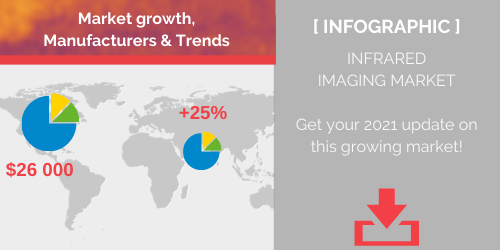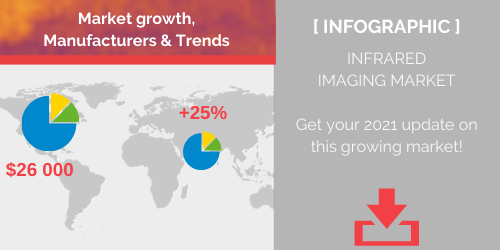Precision Thermal Imaging for Hunting & Leisure: Premium European Solutions for ...
The Hunting & Leisure market is evolving—driven by advanced technology, changing regulations, and the expectations of a new generation of responsible hunters...

May 07, 2020 . 3min read
The market for infrared technology is growing exponentially. Infrared technology, once used exclusively in security and defense applications, is now rapidly making inroads into non-military markets. The technology has gradually become more accessible and is now present in solutions we use every day, like home automation, for example.
Read on for a closer look at where the infrared market stands in 2020.
Global market still driven by military demand
The global market for infrared technology is growing rapidly and still offers many opportunities. Military-grade infrared imaging systems had a good year in 2019, with worldwide growth of 8%, mainly driven by an increase in US defense spending and US military programs to upgrade existing infrared systems. There are currently more than 200 major military infrared programs worldwide. These programs, combined with the development of new advanced infrared detection technologies, should push the global military infrared imaging market to $14 billion by 2024.
In terms of where the major markets are located. the United States remains the leading supplier of military-grade infrared systems. However, Europe, Israel, and China are also major providers. And purchases by countries in the Middle East, Africa, and other regions are on the rise.
At the same time, the technology has become more affordable and accessible, which has facilitated its integration into non-military applications from hunting to drones. And the number of uses for infrared technology is growing. As volumes increase, prices decrease. In terms of research and development, infrared technology is playing a key role in fields like smart buildings and autonomous vehicles.
However, the market is severely lacking a framework to facilitate the integration and calibration of infrared detectors. It also remains very dependent on the geopolitical context and military spending.
Market challenges
The infrared market is very regulated when it comes to detector imports/exports. The Wassenaar Arrangement on Export Controls for Conventional Arms and Dual-Use Goods and Technologies was implemented in 1996 with 33 participating countries.
Dual-use goods and technologies are products that are considered strategic. Although they are intended for non-military use, these sensitive goods and technologies could be employed for military applications.
The United States has its own regulations for the exportation of US-made military equipment: ITAR (International Traffic in Arms Regulation).
The majority of infrared cameras manufactured worldwide contain at least one US-made component, which makes them subject to ITAR.
This has a negative impact on market growth. However, for component manufacturers outside the US, it is also an opportunity: By using European-made components instead of US-made ones, camera manufacturers can avoid ITAR compliance issues.
Last but not least, infrared is a strategic technology for any nation. Therefore, there is a desire to avoid dependency on foreign suppliers. However, not all countries support the technology equally. In China and the US, for example, investment in R&D and infrastructure is high.
In technical terms, the barriers to entering the infrared market remain substantial. This high-tech market requires advanced knowledge of manufacturing techniques and a high investment capacity due to the costs of the equipment needed and, especially, cleanroom equipment.

Key market players
The infrared market is still dominated by several well-established players. However, newcomers from Asia should not be ignored. These new players are already at the state of the art in terms of technology and possess the necessary production capacities to address the global market.
Nevertheless, partnerships and other joint initiatives between existing market players will allow them to grow on the thermal imaging market and expand their global presence.
Some of the current market leaders include: Flir Systems, Bae Systems, Leonardo DRS, L3, LYNRED, Lockheed Martin, Elbit Systems, Raytheon, Jenoptik, Safran, Thales, Guide Infrared, and Zhejiang Dali.
Technological advances
In terms of products, resolutions have increased steadily, with efforts to increase the number of pixels and reduce pixel pitches, which have come down from 45 µm to 12 µm and under.
Sensitivity has also increased, with R&D to improve NETD (noise-equivalent temperature difference).
Currently, there is no real alternative to infrared technology. No other technique can meet the demands that thermal imaging can. Likewise, no other current technology can compete with infrared in terms of materials that are technically feasible and that can contribute to bringing product costs down. Research on graphene in Asia is worth keeping an eye on, however.
Would you like to learn more? Download our infographic with our latest insights into the infrared market.
